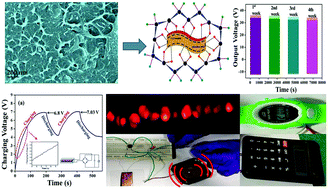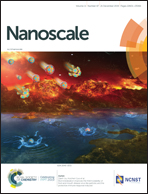Morphological interference of two different cobalt oxides derived from a hydrothermal protocol and a single two-dimensional metal organic framework precursor to stabilize the β-phase of PVDF for flexible piezoelectric nanogenerators†
Abstract
Here, we have fabricated a piezoelectric nanogenerator (PENG) composed of a Co-oxide (Co3O4) doped electro active PVDF based nanocomposite for efficient piezoelectric energy harvesting application where the Co3O4 inclusion favours nucleation and polar β-phase stabilization in the nanocomposite. The morphological effect on the nucleation and β-phase stabilisation of PVDF has been explored experimentally. The flake-like morphology of Co3O4 nanoparticles, synthesized by using a MOF, has a more effective surface area to nucleate and stabilise the β-phase of PVDF than that of rod-like (hydrothermal) and spherical (commercial) nanoparticles. The PENG with PVDF and the 1.5 wt% MOF based Co3O4 (MPNG) shows an excellent open circuit voltage (∼37 V) and short circuit current (∼0.711 μA) upon human finger tapping. The maximum power density generated from the MPNG is ∼8.55 μW cm−2, which is well sufficient for the driving of portable electronic devices like LEDs, calculator wrist watches, humidity sensors etc. Also, from various easily accessible mechanical and biomechanical energy sources like heel pressing, walking, and machine vibration, the MPNG is capable of harvesting energy.



 Please wait while we load your content...
Please wait while we load your content...